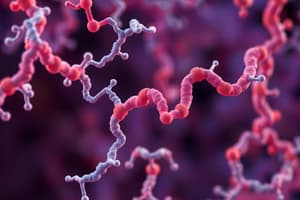Podcast
Questions and Answers
What type of bond is formed when a non-metal atom is receiving electrons?
What type of bond is formed when a non-metal atom is receiving electrons?
- Ionic bond
- Hydrogen bond
- Covalent bond (correct)
- All of the above
Which term refers to the force of attraction within the same molecule?
Which term refers to the force of attraction within the same molecule?
- Hydrogen bonding
- Vandal Wal forces
- Intramolecular bonding (correct)
- Intermolecular bonding
What is the function of a buffer in a solution?
What is the function of a buffer in a solution?
- Release H+ if it's a very basic medium
- Take up H+ from the medium if it's too acidic
- Resist changes in pH (correct)
- All of the above
Which statement best describes the similarity between motifs and domains in proteins?
Which statement best describes the similarity between motifs and domains in proteins?
What is denaturation in relation to proteins?
What is denaturation in relation to proteins?
Which property doesn't apply to Globular proteins?
Which property doesn't apply to Globular proteins?
What is the primary function of protein domains?
What is the primary function of protein domains?
What is the purpose of the $β$-$α$-$β$ motif in protein structures?
What is the purpose of the $β$-$α$-$β$ motif in protein structures?
Which of the following is a key function of valence electrons?
Which of the following is a key function of valence electrons?
What is the role of hemoglobin in the body?
What is the role of hemoglobin in the body?
What is the role of chaperone proteins in the cell?
What is the role of chaperone proteins in the cell?
What is the difference between cis and trans amino acids in protein structures?
What is the difference between cis and trans amino acids in protein structures?
What is the key difference between cis and trans amino acids?
What is the key difference between cis and trans amino acids?
What is the primary function of chaperone proteins?
What is the primary function of chaperone proteins?
What is a characteristic feature of globular proteins?
What is a characteristic feature of globular proteins?
Which of the following is an example of a globular protein?
Which of the following is an example of a globular protein?
What is the purpose of protein domains?
What is the purpose of protein domains?
How do cis and trans amino acids affect protein structure?
How do cis and trans amino acids affect protein structure?
Flashcards are hidden until you start studying
Study Notes
Amino Acids and Proteins
- Cis and trans amino acids differ in the spatial arrangement of the amino and carboxyl groups attached to the alpha carbon.
- In cis amino acids, the amino and carboxyl groups are on the same side of the alpha carbon, resulting in a bent conformation.
- In trans amino acids, the amino and carboxyl groups are on opposite sides of the alpha carbon, resulting in a linear conformation.
Chaperone Proteins
- Chaperones are proteins that assist the conformational folding or unfolding of large proteins or macromolecular protein complexes.
Globular Proteins
- Globular proteins are a type of protein that folds into a compact, rounded shape.
- Example: Hemoglobin, a globular protein found in red blood cells.
- Globular proteins have a variety of functions in the body, including acting as enzymes, hormones, immunoglobulins, and transport molecules.
- They are soluble in water or in lipid bilayers.
- Quaternary structure is held together by noncovalent forces.
Protein Domains
- Protein domains are distinct regions within a protein that can fold independently and often carry out specific functions.
- A protein domain can be thought of as a building block that can be combined with other domains to create proteins with various functions.
- Proteins often contain multiple domains, each of which can perform a different function.
Structural Motifs
- A common structural motif is the β-α-β motif, where two adjacent β parallel strands are connected by an α helix from the C-terminus of strand 1 to the N-terminus of strand.
Valence Electrons
- Valence electrons are electrons in the outer shell of an atom.
- They are essential as they determine chemical properties of the elements.
Enantiomers and Chirality
- Enantiomers are a molecule that has left and right-handed isomers.
- A chiral molecule is a molecule that has an atom bonded to four different groups.
Reactions and Bonding
- The reaction between an acid and a base is called a neutralization reaction.
- Non-metal atoms receive electrons.
- Buffer's function is to resist changes in pH.
- Intermolecular bonding is the force of attraction within the same molecule.
Atomic Number and Protein Structure
- Atomic Number is the number of protons in the nucleus, which identifies which element it is.
- Denaturation is the process of unfolding the protein.
- Lysine and Proline are identified as helix breakers.
- Motifs and domains are independent, and have structural and functional importance to protein structure.
Studying That Suits You
Use AI to generate personalized quizzes and flashcards to suit your learning preferences.




